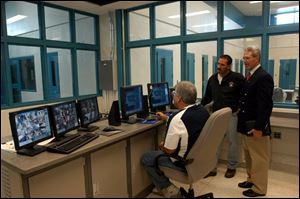
New lockup gets ready for juveniles
9/29/2003
Sgt. Tad Kluck, Dale Mitchell, director of detention, and Judge Brad Culbert of Sandusky County Juvenile Court view the computerized control room of the new detention center.
FREMONT - The Sandusky County juvenile detention program will move into the 21st century early next month when inmates and staff begin occupying a new $3.8 million lockup.
The new detention center, across from the sheriff's office on Countryside Drive, will provide more space and better security than the county's current facility, a converted youth shelter from the 1950s, officials said. The county will dedicate the facility at 11 a.m. tomorrow.
“It's going to bring a peace of mind to the staff,” said Judge Brad Culbert of Sandusky County Juvenile Court. “The big transition is going from basically a staff-secured facility to a structurally secured facility, where that concern and that stress is totally taken away.”
Judge Culbert said the old youth lockup's exterior windows, for instance, offer little deterrent to would-be escapees.
“A lot of kids are risk-takers,” he said. “We had a lot of problems with escapes for awhile.”
In the new detention center, exterior windows are reinforced to prevent breakage. Prisoner intake areas and other common spaces have electronically controlled doors that open only if all other exits are closed.
Detention officers can monitor practically every inch of the building with monitors that display images from 39 cameras.
“Everything in this building is recorded,” said Dale Mitchell, director of juvenile detention.
That compares with the current center's outmoded surveillance system, which has fewer than 10 cameras, he said.
The new center will have about 24,000 square feet and 36 beds, up from less than 10,000 square feet and 24 beds at the old facility. Sandusky County plans to lease a minimum of five beds daily to Huron and Ottawa counties, which will pay a combined $365,000 a year.
Mr. Mitchell said the county will fill the rest of the beds with its own offenders or rent them to other counties day by day.
“We will be full all the time. That's our intention,” he said. “If we have an empty bed, I'm going to sell it, basically.”
Officials need a full house to cover the new center's higher costs. The county spent about $712,000 a year to operate the old detention center and estimate annual expenses of $1.2 million at the new facility, county Commissioner Dan Liskai said.
Officials said some of those extra costs will be offset by income from renting out beds to Huron, Ottawa, and other counties. Sandusky County also will save money because officials will no longer have to send the most dangerous offenders to more secure lockups in other counties.
Construction began in August, 2002. The state paid for 60 percent of the work.
The new center will employ 23 detention officers, up from 16 at the old facility, plus a director, assistant director, program manager, and receptionist. The county contracts out for food service.
Inmates, who now attend classes with Fremont school teachers in a garage at the current lockup, will instead be taught in three classrooms equipped with computers.
The youths will sleep in separate cells, instead of in a dorm-style room like the old center.
And instead of using that dorm space for exercise during bad weather, they'll use a junior-high sized gym that includes a rubberized basketball court with glass backboards.
The gym's white concrete block walls, 26 feet high, include blue and green trim and acoustical tiles to curb echoes. It's one of the few frills in an otherwise Spartan facility and allows the county to meet a state exercise mandate.
“All through this program we tried to be frugal,” Mr. Liskai said, adding that the gym was designed to limit maintenance costs. “The little bit extra that's in there is for the long haul.”
Officials point to the new center's cells. Each is 6 feet by 12 feet and contains a steel sink, toilet, and mirror. Inmates will sleep on concrete slabs topped with vinyl-covered mattresses.
“The only thing a kid is allowed to have in here is a religious book of his choice and a Styrofoam cup,” Mr. Mitchell said.